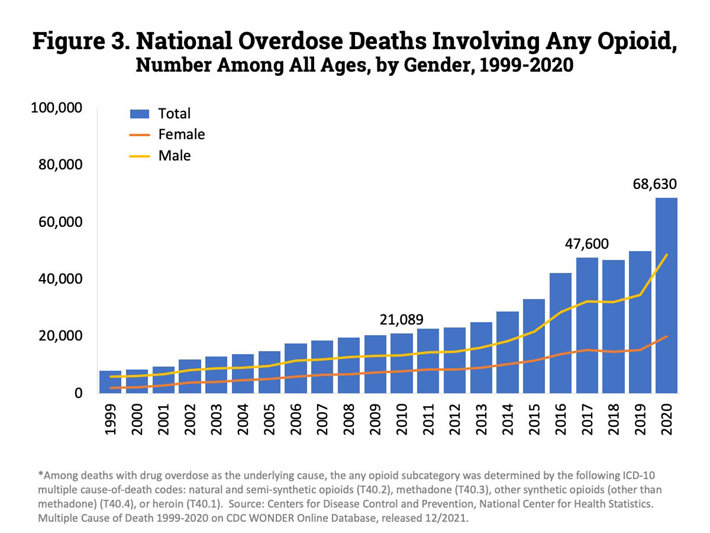What Is Rainbow Fentanyl?

Alarming reports of law enforcement seizing batches of brightly colored fentanyl have surfaced nationwide. The fentanyl tablets, dyed with colors of the rainbow, look similar to candy. Drug Enforcement Administration officers and Department of Justice officials are concerned that the bright rainbow colors, sidewalk chalk consistency, and candy shape will make the life-threatening drug seem less harmful to young adults, teens, and even children.
Concerning Reports from Law Enforcement Officials
In August 2022, reports surfaced of “rainbow fentanyl” seizures occurring in Arizona, Oregon, California, and the District of Columbia. In one week, border patrol agents confiscated more than 15,000 rainbow fentanyl pills at Arizona’s Nogales Port of Entry. This incident followed a similar seizure of 250,000 fentanyl pills earlier that week.
Law enforcement officers noted that some pills were brightly colored. Reports suggested the pills were dyed in eye-catching rainbow patterns, likely a form of color-coding used to assist traffickers and dealers in differentiating different types of fentanyl. Some of the pills also tested positive for methamphetamine.

Further, seizures are not just occurring on the border. Rainbow fentanyl seizures have occurred as far north as Oregon, with two notable seizures in August 2022 prompting the United States Attorney’s Office for the District of Oregon to put out a press release urging Portland residents to be on the lookout for rainbow fentanyl. According to Oregon law enforcement, officers seized over 800 fentanyl pills and four grams of multi-colored powder fentanyl, enough fentanyl to kill over 1,000 Oregon residents.
Reports suggest that the growing availability of illicit fentanyl in Oregon is directly responsible for a surge in opioid overdose deaths throughout the state. Steve Mygrant, Chief of the Narcotics and Criminal Enterprises Unit of the U.S. Attorney’s Office for the District of Oregon, flagged the seizures of rainbow fentanyl as indicative of severe public health risks Oregon residents now face. He said, “We urge all Oregonians to be on the lookout for fentanyl in our community and respect the highly-toxic nature of this substance. Fentanyl is commonly disguised in fake prescription pills. If you find or come in contact with pills not dispersed by a licensed pharmacist, assume they are fake and potentially lethal. Fake pills are indistinguishable from real pills.” Also, it’s not just Portland law enforcement officials taking this development seriously. DEA agents as far north as Seattle have increased their search and seizure activities, intent on preventing rainbow fentanyl from falling into the hands of unsuspecting users or children.
Information on Fentanyl
Fentanyl is a synthetic opioid 80 to 100 times more powerful than morphine and 30 to 50 times more powerful than pure heroin. For context, a 3-milligram dose of fentanyl, just a few grains of the substance, is enough to kill an average adult male. Fentanyl is so potent that getting some of the drug powder on one’s skin can cause an overdose. People who consume fentanyl for its mind-altering effects may also experience side effects like relaxation, euphoria, pain relief, sedation, confusion, drowsiness, severe dizziness, nausea, vomiting, urinary retention, pupillary constriction, and dangerous respiratory depression.
The developing trend of rainbow fentanyl is particularly concerning because teenagers or young adults who may be averse to using drugs could be peer pressured into using rainbow fentanyl due to its more appealing, even harmless-looking colors. Further, while it is unlikely that the drug would be marketed to children, it would be devastating for children to come across the drug, mistake it for candy, and swallow it.
Fentanyl Statistics
Before the rainbow fentanyl trend surfaced, fentanyl had already become America’s single most dangerous drug, responsible for more fatal overdoses than any other drug. According to the Centers for Disease Control and Prevention, overdose deaths involving synthetic opioids in 2020 (primarily fentanyl) were over 18X the number of synthetic opioid overdose deaths in 2013. From 2019 to 2020, overdose deaths involving fentanyl spiked by 56%, with more than 56,000 Americans losing their lives to such drugs in 2020.

Public health officials warn that while prescription fentanyl may have set off the fentanyl addiction crisis that currently plagues America, the majority of fatal drug overdoses occurring today are from illicit, clandestine lab-produced fentanyl analogs. These substances are fentanyl-like drugs made by drug traffickers and dealers, not fentanyl made by pharmaceutical companies. According to the CDC, illicit fentanyl analogs were the primary contributor to a 30% increase in fatal drug overdoses from 2019 to 2020 and another 15% increase in fatal overdoses from 2020 to 2021.
According to CDC preliminary data, 93,655 Americans died from drug overdoses in 2020 and 107,622 died in 2021. Sadly, 2022 is shaping up to be just as bad as 2021, if not worse.
Help for Those Addicted to Fentanyl
The developing trend of rainbow fentanyl exacerbates the already devastating fentanyl epidemic that has taken lives in every state across America. Now more than ever, people who suspect their family members or loved ones might be experimenting with the drug must act fast to ensure those individuals get help. Just one exposure to fentanyl can be fatal, and people who become addicted to the drug risk an overdose every time they use fentanyl.
People who are addicted to fentanyl must seek help at residential drug rehab centers, as only residential programs have the tools needed to help fentanyl addicts break free from their dependence on the drug.
Sources:
- USA Today. “What is ‘rainbow fentanyl?’ Nationwide, officials report ‘deadly’ colorful pills, powder.” USA Today, 2022. usatoday.com
- DOJ. “Federal Law Enforcement Officials Warn of “Rainbow Fentanyl” Appearing in Oregon.” United States Attorney’s Office District of Oregon, 2022. justice.gov
- CDC. “Fentanyl.” Centers for Disease Control and Prevention, 2022. cdc.gov
- CDC. “U.S. Overdose Deaths In 2021 Increased Half as Much as in 2020 – But Are Still Up 15%.” Centers for Disease Control and Prevention, 2022. cdc.gov
- NIDA. “Overdose Death Rates.” National Institute on Drug Abuse, 2021. nida.nih.gov


 ®
®